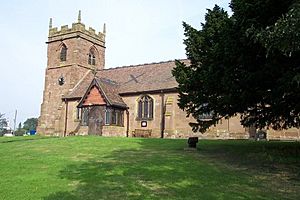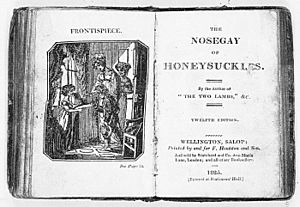Lucy Lyttelton Cameron facts for kids
Quick facts for kids
Lucy Lyttelton Cameron
|
|
|---|---|

Nosegay of Honeysuckles by Lucy Lyttelton Cameron, 1825 print
|
|
| Born | 29 April 1781 Stanford-on-Teme, UK |
| Died | 6 September 1858 Swaby, UK |
| Genre | Children's fiction |
Lucy Lyttelton Cameron (born Lucy Butt) was a British writer who lived from 1781 to 1858. She wrote many stories for children, often with religious messages. She also edited a magazine for young children.
Early Life and Learning
Lucy Lyttelton Cameron was born in Stanford-on-Teme, a village in the UK. She was named after her godmother, Lady Lucy Fortescue Lyttelton. Her father, George Butt, was a vicar (a type of church leader) and a poet. He was also a chaplain to King George III. This meant he had a special role serving the King.
Lucy studied many languages when she was young, including French, Italian, and Greek. From 1792 to 1797, she went to Reading Abbey Girls' School. This school was also attended by the famous writer Jane Austen, who wrote about it in her novel Emma.
Lucy and her sister, Mary (who later became Mary Martha Sherwood), had a very strict upbringing. Their parents wanted them to have good posture. Mary had to wear a special backboard and an iron ring to help her stand up straight. Lucy was thought to be more delicate, so she didn't have to wear them.
Through her family, Lucy met important people in London. These included Elizabeth Carter, a well-known female scholar, and Humphry Davy, a famous inventor. She also met writers like Hannah More in Bristol.
Lucy started writing when she was still young. The year after she left school, she wrote The History of Margaret Whyte. Her sister Mary was already a published writer by then. Lucy and Mary lived with their mother in Bridgnorth. Both sisters taught at the local Sunday School. Their stories were often written for the children they taught there.
Marriage and Family Life
In 1806, Lucy Butt married Charles Richard Cameron, a vicar. She then took his last name, becoming Lucy Lyttelton Cameron. They moved to Snedshill in Shropshire, where Charles was a church leader at St Michael's Church.
Lucy and Charles had twelve children together. They also took in other family members. When Lucy's sister moved to India, Lucy and Charles adopted their niece. Later, in 1818, Lucy's only brother lost his wife. He couldn't care for his seven children alone. So, Lucy's sister adopted four of them, and Lucy took in the other three daughters.
This meant Lucy's household became very busy! Luckily, a kind industrialist named Isaac Hawkins Browne left her an allowance of £50 a year when he died. This helped with the extra costs. The Camerons lived in Shropshire for 25 years before moving to Swaby in Lincolnshire.
Her Writing Career
Lucy Cameron wrote throughout her life, just like her brother and sister. Her sister, Mary Martha Sherwood, was even more famous and wrote many popular books.
Some of Lucy Cameron's most well-known stories include The Raven and the Dove, The Nosegay of Honeysuckles, Martin and his Two Sunday Scholars, and The Pink Tippet. She wrote about 400 different works in total! These were published by a company in Shropshire.
Besides writing, Lucy was also the editor of a magazine called Nursery and Infants' Schools Magazine. She worked on this magazine for many years, from 1831 to 1852. Her books were also published in America.
Lucy and her sister are known for changing children's literature. Before them, children's stories mostly focused on teaching kids to follow rules and fit into society. But Lucy and Mary's stories focused more on the feelings and goals of individual children. This made their books very popular, not just in Sunday schools but for all children to read for fun. They were widely recognized for their work. However, around 1870, new styles of books became popular, and their stories were mostly found only in Sunday schools again.
Lucy Lyttelton Cameron passed away in 1858 and was buried in Swaby.



